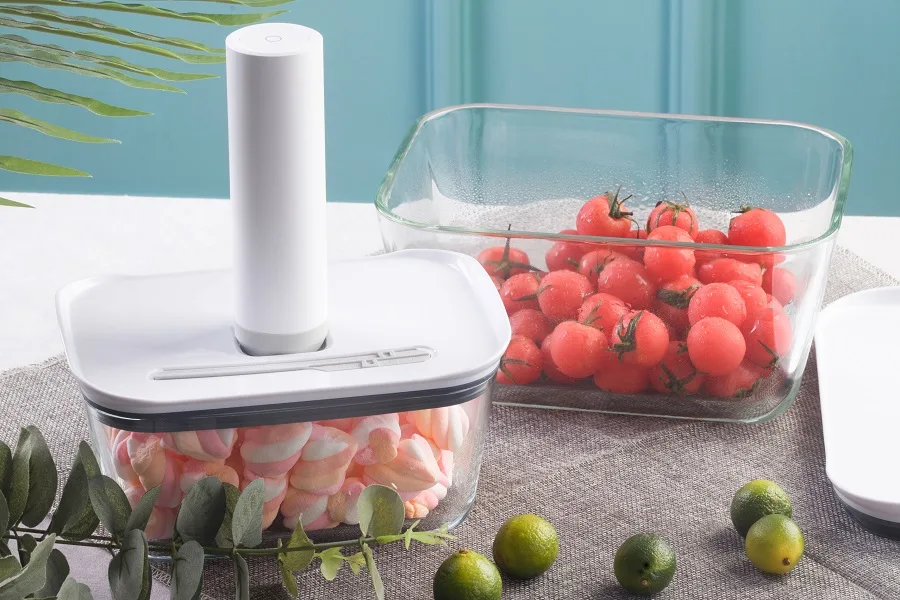Choosing the right vacuum food container is crucial to extending the shelf life of your food and maintaining its freshness. There are a variety of vacuum food containers available on the market, so it's important to understand how to choose one that suits your needs. In this article, we'll cover some of the key factors and considerations when choosing a vacuum food container.

1. Container material
Vacuum food containers are usually made of different materials, such as plastic, glass, and stainless steel. Each material has its advantages and disadvantages, so it's important to choose one that suits your needs.
Plastic vacuum food containers: Plastic containers are generally lightweight and easy to carry and store. They also have good impact and corrosion resistance. However, some cheap plastic containers may release harmful substances, so it is important to choose high-quality food-grade plastic containers.
Glass vacuum food containers: Glass containers are generally more durable and won't stain or smell from food. They are also easier to clean and maintain. However, glass containers are heavy, fragile, and not suitable for carrying and storing large amounts of food.
Stainless steel vacuum food containers: Stainless steel containers have excellent corrosion resistance and high-temperature resistance. They also don't release harmful substances and are ideal for storing acidic foods. However, stainless steel containers are heavier and more expensive.
2. Container size and shape
Choosing the right container size and shape is key to ensuring effective food storage. Here are some considerations:
Vacuum food container size: The size of the container should be chosen based on the needs of the individual or family. If you frequently need to store large amounts of food, choosing a larger container may be more appropriate. Additionally, the height and width of the container need to be considered to ensure it is suitable for the type of food being stored.
Vacuum food container shape: The shape of the container is also an important factor. Some containers have a square or rectangular shape, suitable for storing bulk foods such as cuts of meat or vegetables. While other containers have a round or oval shape and are suitable for storing liquid or semi-solid food.
Stacking and Storage: It's also important to consider the container's stacking and storage capabilities. Some containers have a stackable design to save storage space. In addition, the tightness of the container also needs to be considered to ensure that the food does not leak or become contaminated.
3. Sealing performance
The sealing performance of vacuum food containers is the key to ensuring that the vacuum environment is not destroyed. Here are some sealing performance considerations:
Sealing device: The sealing device of the container should have good sealing performance to ensure that the inside of the container is isolated from the outside world. Some containers have elastic seals or silicone gaskets that provide a better seal.
Air extraction device: Some vacuum food containers are equipped with an air extraction device, which can easily extract the air inside the container. These extraction devices can be manual or electric. It is very important to choose an extraction device that suits your usage habits and needs.
Sealing durability: The sealing performance of the container should be durable and stable to ensure that the vacuum environment will not be destroyed. Some containers have a self-sealing feature that automatically closes the seal after pumping.
4. Brand and price
Choosing a well-known brand of vacuum food containers ensures product quality and performance. These brands usually have good word-of-mouth and customer reviews. However, branded products are usually more expensive. If your budget is limited, you can also choose some cost-effective products.
5. Other matters needing attention
When choosing a vacuum food container, you also need to pay attention to the following points:
Cleaning and Maintenance: Containers should be easy to clean and maintain to avoid bacterial growth and odor development. Some containers are dishwasher safe, while others require hand washing.
Types of food: Different containers are suitable for storing different types of food. Some containers are suitable for storing solid foods, such as meats and vegetables, while others are suitable for storing liquid foods, such as soups and sauces.
Durability of the container: The container should have good durability to ensure long-term use. Some containers are impact and temperature-resistant and can be used in different environments.
When choosing a suitable vacuum food container, you need to consider factors such as container material, size and shape, sealing performance, brand, and price. The material of the container should meet food safety standards, the size and shape should suit the needs of the individual or family, the sealing performance should be good, the brand should be reliable, and the price should be reasonable. In addition, cleaning and maintenance of the container, the type of food it is suitable for, and durability also need to be considered. Choosing suitable vacuum food containers can ensure the preservation and freshness of food, providing people with a convenient, economical, and environmentally friendly way to store food.
mia
ltt@bsfmould.com

